|
CESD is a member of the Hill
Country Astronomers club in Fredericksburg, Texas |
|
CESD is a member of the Hill
Country Astronomers club in Fredericksburg, Texas |
Alamo
Springs Ranch Observing site -
ClearSky Clock (from 1 mile away at Old Tunnel State Park):

| All Images on this page are © 2018, C. E. Steuart Dewar. They may be downloaded for any non-commercial use. Any commercial use requires explicit written permission - Thank you. |
Messier Marathon, 2017
This was my third Messier Marathon (the second was In 2007) and this time I was taking no chances. In a "Messier Marathon" an astronomer tries to observe as many as possible of all 110 deep sky objects (Clusters, nebulae, galaxies) in a single night using only star charts (and as a purist: no computers or GoTo!). There is a brief window usually at the end of March when the Sun and Moon are both just out of the way enough to see all 110 Messier objects.
They say a picture is worth a thousand words:
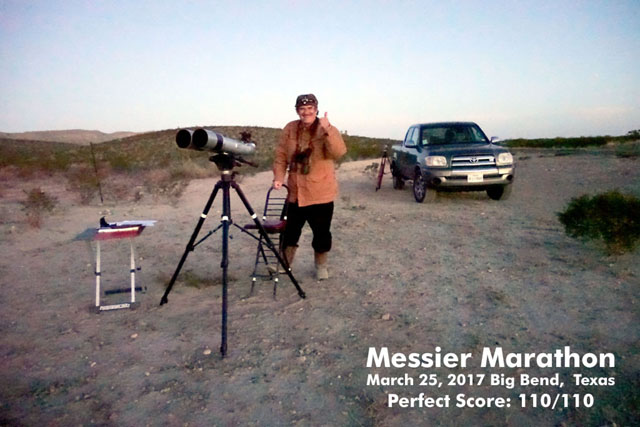
The result was recorded on the official SEDS Page for 2017 that reports Messier Marathon results from around the world - this being one of less than a dozen perfect Marathon scores so far recorded there for 2017.
Big
Bend has Bortle 1 skies and so I headed down there in my camper and
stayed at an RV Campground just outside the Park. Originally,
I
was going to try the Marathon inside the park itself, but I found a
good place on the side of the road near the campground and since the
night before, I had only seen one car go by in the space of 3 hours, I
figured that would not be a problem. I had a gasp moment when the
horizon was filled with clouds that appeared out of nowhere, but
fortunately, they dissipated just in time for me to catch M76 and M110
before they got too low. My viewing instrument was, as in 2007, Saturn
III binoculars (100mm aperture with 37x eyepieces) and a laser pointer
(which I find perfect for quickly locating items). In 90 minutes, I had
caught all the evening items, and knew this was going to be a good run.
After M92, I went back to the campground for 4 hours since I had to
wait then for the remaining Messier objects to rise. As I was packing
up, a vehicle sped past me on the road going at least 70mph and with no
lights at all(!). I never did see any lights on the car as it
disappeared into the distance (maybe they were driving with
night-vision equipment? Or maybe they were just inebriated?).
I went back to the observing site a little after 3am and quickly got down to the point where there were only 9 left. Then it was down to three: M72 (a very faint globular), M73 (a weird little asterism) and the one Messier I could not get in 2007: M30 - a globular cluster in Capricorn. M30 doesn't even rise until after 6am, and astronomical dawn was at 6:28 - so I knew there was going to be precious little time. After getting M72 and M73 out of the way, it was now down to the very last one. By 6:25, the sky was no longer inky black, and I realized it was a race against time. As soon as M30 hit an elevation of 3 degrees above the horizon, I started looking for it (I had already checked out the observing site to make sure I could see down to within 1 degree of the horizon). The bowl of stars at the bottom of Capricorn is the pointer, and at 6:32am, I had M30 fully visible in the Saturn III's at an elevation of 3 1/2 degrees. I watched it for another 15 minutes and although the visibility was obviously improving as it gained altitude, this was almost completely offset as the skies got lighter and lighter. This time, I found over three quarters of the objects from memory, so the next challenge is an M-cubed Marathon (Messier Marathon from Memory). The full log-sheet for the 2017 Marathon can be found here. Sadly, my dog Freeway, who accompanied me on the trip and had a great time, succumbed to end stage renal failure a few days later, but at least he was there to participate in the celebration (I got the champagne, he got the carrots - his favorite treat).
Dewar's Eagle Cluster...
In 2007, I posted on Cloudy Nights about an open cluster near Sagittarius that looks just like an Eagle coming in for a landing. Surprisingly, it seems there are no references to this striking visual appearance. The core of this cluster is recognized as NGC 6774 or Ruprecht 47 and is of interest as it might be one of the oldest clusters close to our sun (it's about 1,000 lty distant). It's visible in larger binoculars (my Celestron 15x70's show it nicely). It's located just 2 degrees from Rho1 Sagittarii (mark a line from 62 Sagittarii to Rho1 Sagittarii and go 2 degrees beyond to get right to it). There's a finder chart in the Cloudy Nights post. If you see this object and agree/disagree about its appearance, email me and let me know! For now, until advised otherwise, I am taking dibs on the name the "Eagle Cluster" for this object! I will photograph it shortly and post it here. In the meantime, here's a graphic representation of what the cluster looks like through binoculars (if you look at a skychart, you will have difficulty seeing it, even though it's obvious when viewed). This shows all the brighter stars in the cluster in their correct positions.
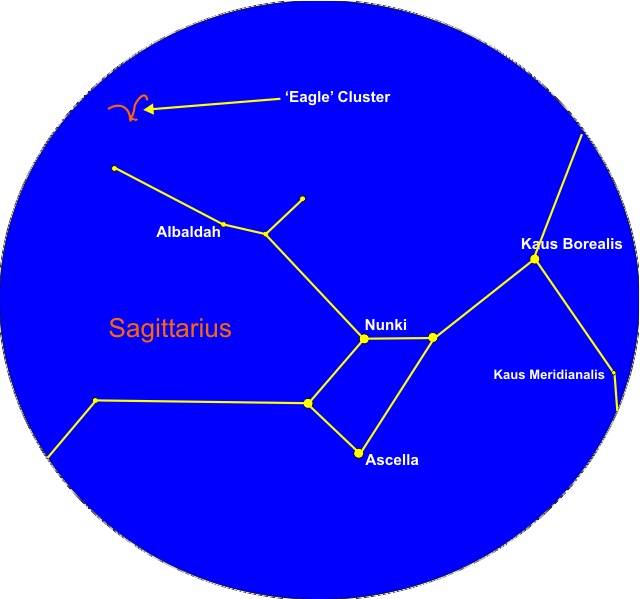
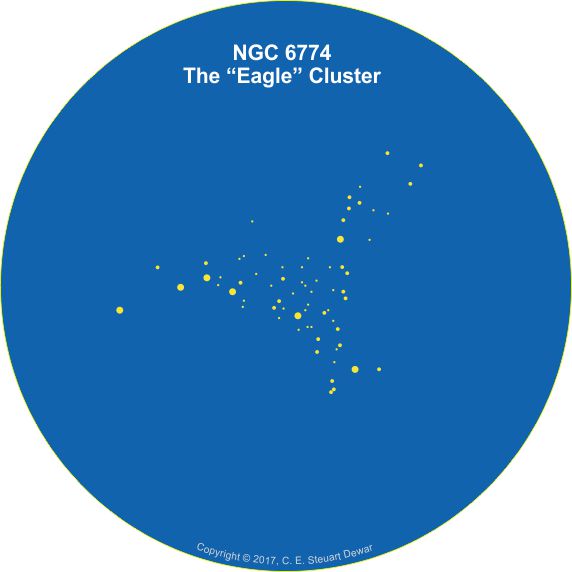
For example, if you request an image of NGC 6774 from the Digitized Sky Survey (DSS), you get this image:
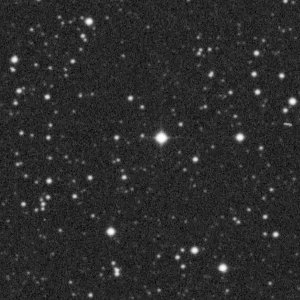
which only covers the core of this open cluster.
Astrophotographs - Most Recent
July 3rd, 2018
Saturn was still a bit low just after midnight on July 3rd, and clouds were starting to move in, but I decided to try a few shots anyway, in spite of the below-average seeing. EdgeHD 11 at F25 (F10 with TV 2.5x Powermate), AP Mach1/GTO, ASI-1600mc, 1,250 of 5,000 frames stacked in AutoStakkert, wavelets in Registax and final adjustments in Photoshop, July 3, 2018. I always think I can see hints of the Encke gap in photos like this (esp. on the left edge), but the truth is that these are more likely to be artifacts of the Image Processing Enhancements (but one can always hope!).
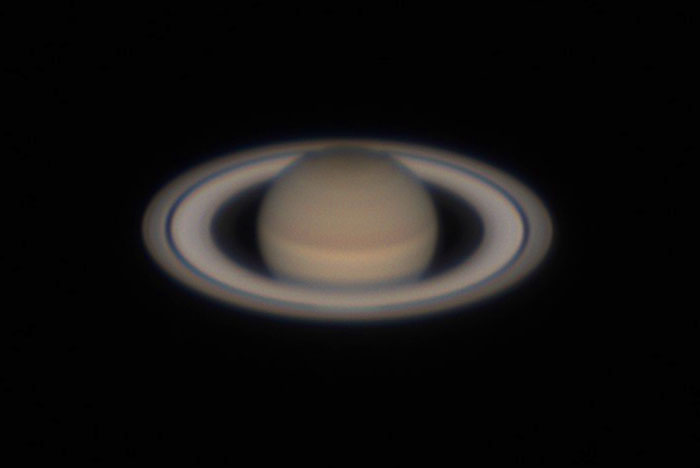
June 27/28th, 2018
It'll be July in Texas in a few days, and it's very hot (100°F here today). It's also been rather windy, so the seeing has not been great, but tonight (June 27th) was better than it's been all month, so I took the opportunity to photograph Jupiter. This evening, the Great Red Spot was front and centre, just as Europa (clearly visible as a disk) was about to transit the planet. This was a quick processing of an image from tonight - more time might eke out a bit more detail. EdgeHD 11 at F25 (F10 with TV 2.5x Powermate), AP Mach1/GTO, ASI-1600mc, 500 of 5,000 frames stacked in AutoStakkert, wavelets in Registax and final adjustments in Photoshop, June 27, 2018.
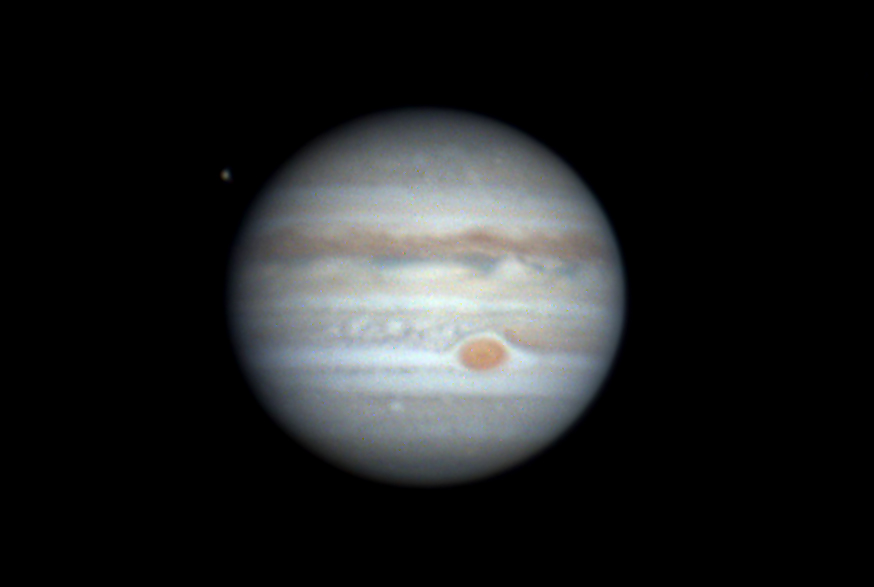
It's getting cold here (even in Texas) for staying out all night imaging, but I had a new F7 reducer for my C-11 Edge and wanted to try it out with some new capture software. This was just a first quick attempt on the Orion Nebula (M42). It picked up a little bit of the color, while still clearly showing the four stars of the Trapezium (that light up the gases that form the Nebula). This was a set of ten exposures of 90s each with a ZWO color camera (captured raw and then converted to color and stacked, stretched in Nebulosity 4.0).The photograph pretty closely matches what you see through a very large amateur telescope visually.
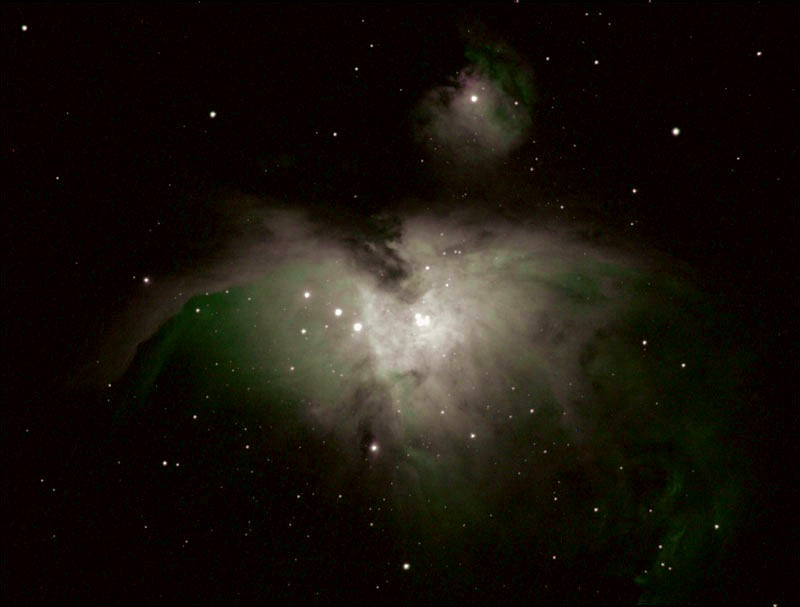
The August 2017 total eclipse was an extraordinary event. I traveled to Alliance Nebraska for the eclipse as this was on the centerline, and historical records for the past 20 years indicated it had the best likelihood of having clear skies on the eclipse line. A total solar eclipse is truly a "religious" event (even if one is not religious!!). One can not help being filled with awe at the sight. First, a montage of the ingress and egress of the moon as well as totality. All these pictures were taken with a Sony RX100-M3 camera at the 600mm Zoom setting. Solar film was taped to the front of the lens for the pictures (except for totality, when it was briefly removed).
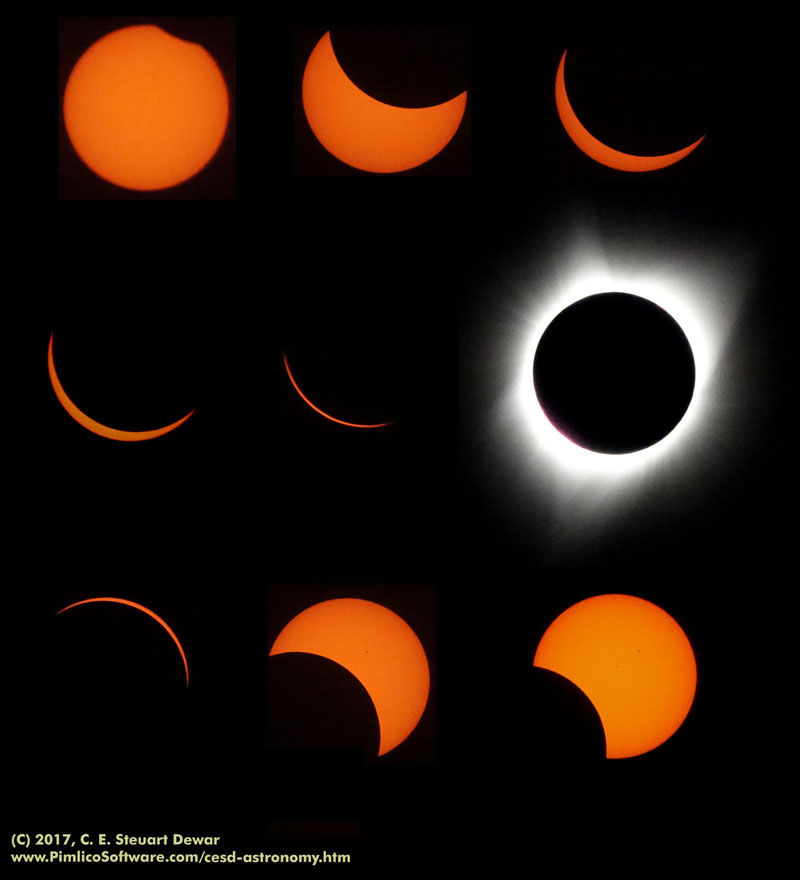
As the totality ended, there was a brief display of the beautiful Diamond Ring effect as the sunlight starts to spill over the edge of the moon:
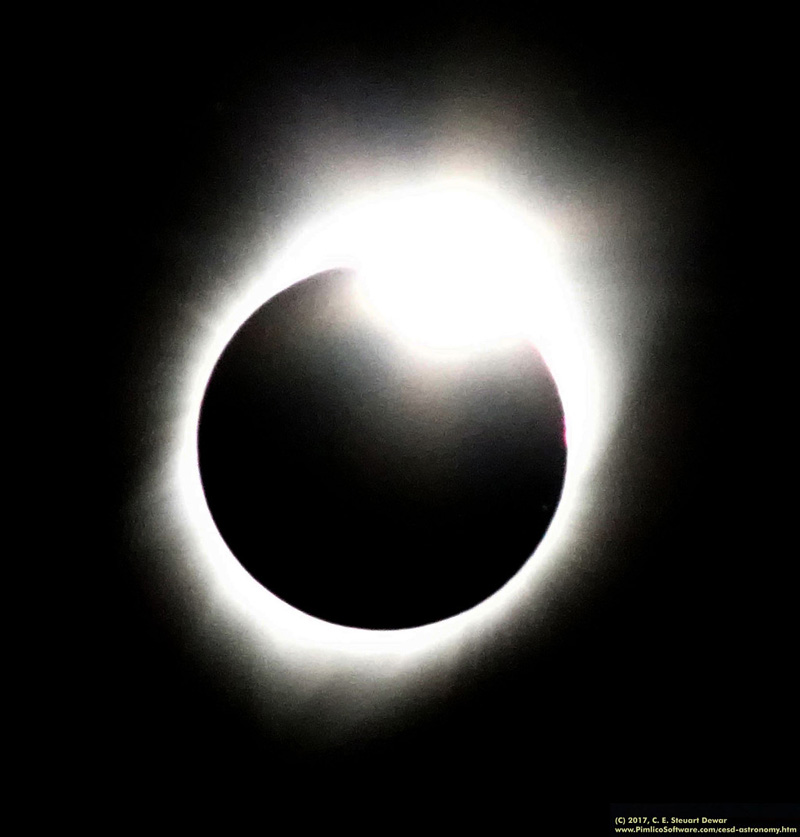
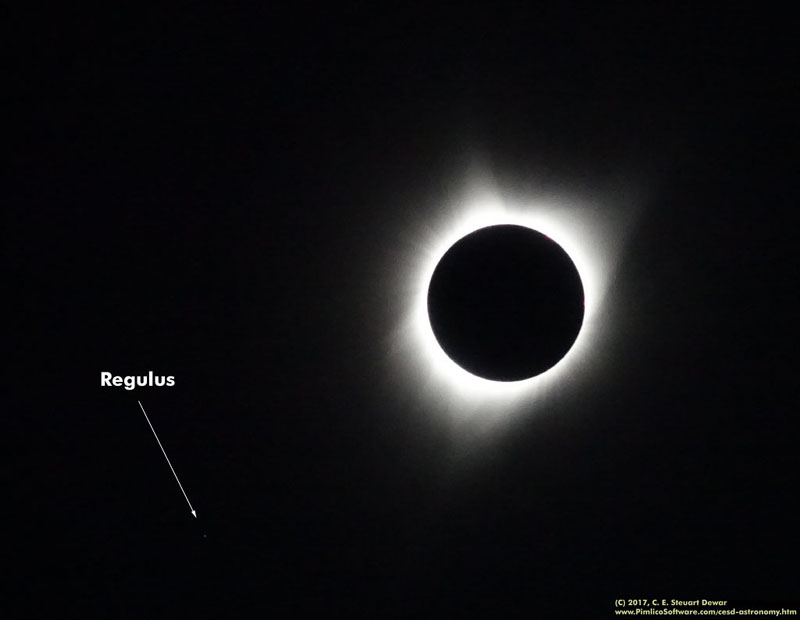
Jupiter
These photographs of the Europa transit of Jupiter were taken with an Edge11HD on a Mach1/GTO mount with an ASI-1600MC camera. Software includes SharpCap to capture the images, Registax for stacking lunar/planetary images, and DeepSkyStacker for the Deep Sky Images. All images were then processed further in Photoshop.
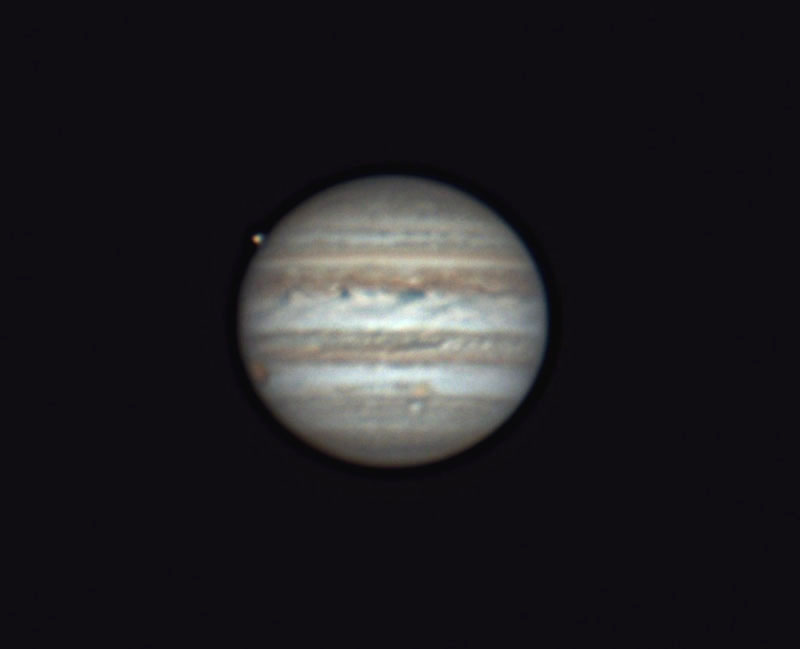
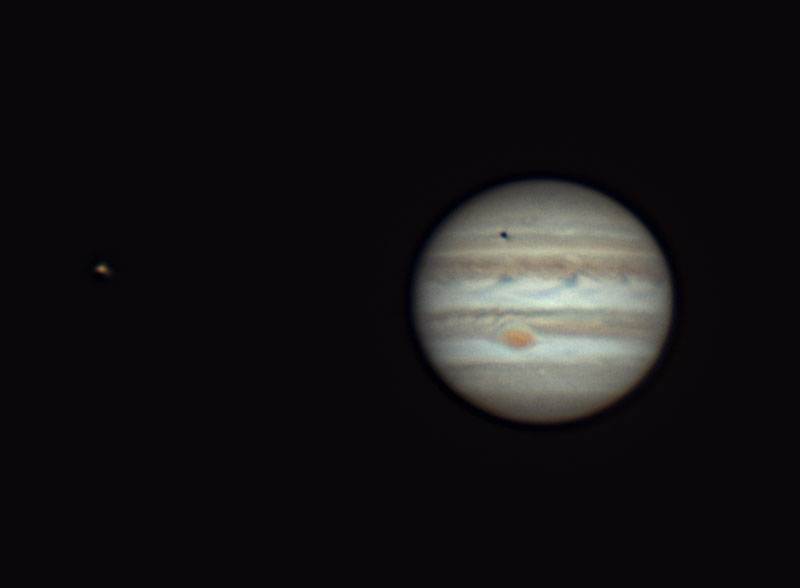
An hour later into the transit, Europa's shadow is clearly visible above the top main band and Europa itself appears faintly as a lighter round spot on Jupiter to the right of the shadow). The moon off to the left is Io.
The next set of photographs here were taken with an AstroPhysics 130GTX on a Mach1/GTO mount with an ASI-1600MC camera. Software includes SharpCap to capture the images, Registax for stacking lunar/planetary images, and DeepSkyStacker for the Deep Sky Images. All images were then processed further in Photoshop.
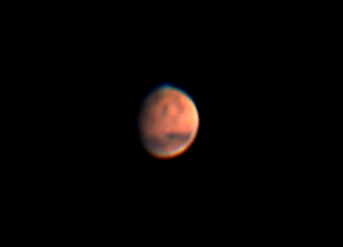
Mars - on August 8/6/2016 - at this point Mars was only 12.3 arc seconds in diameter and the phase is clearly visible. This was a stack of 200 out of 500 images. Seeing was below average.
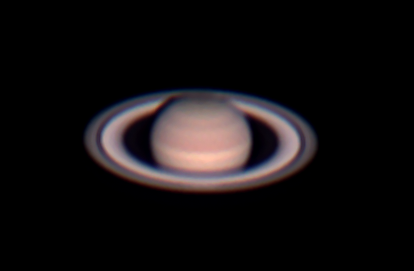
Saturn - on August 8/6/2016 - a stack of 200 out of 500 images (Seeing was below average)
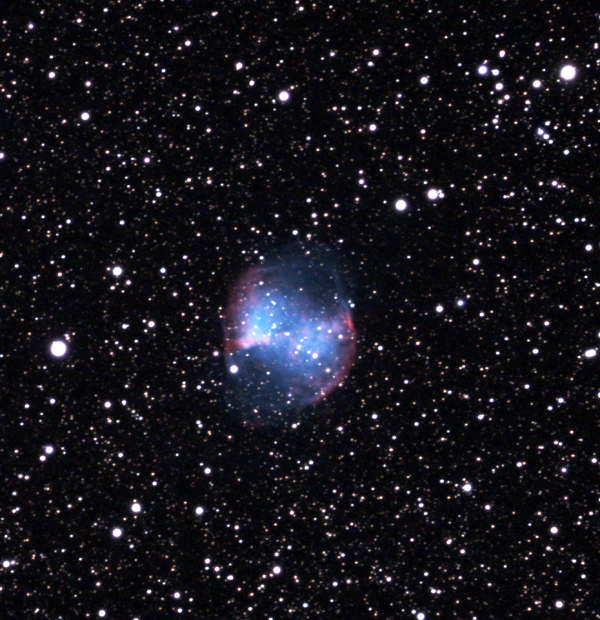
M27 (Dumbell Nebula) on September 20, 2016 - stack of 10x120s exposures
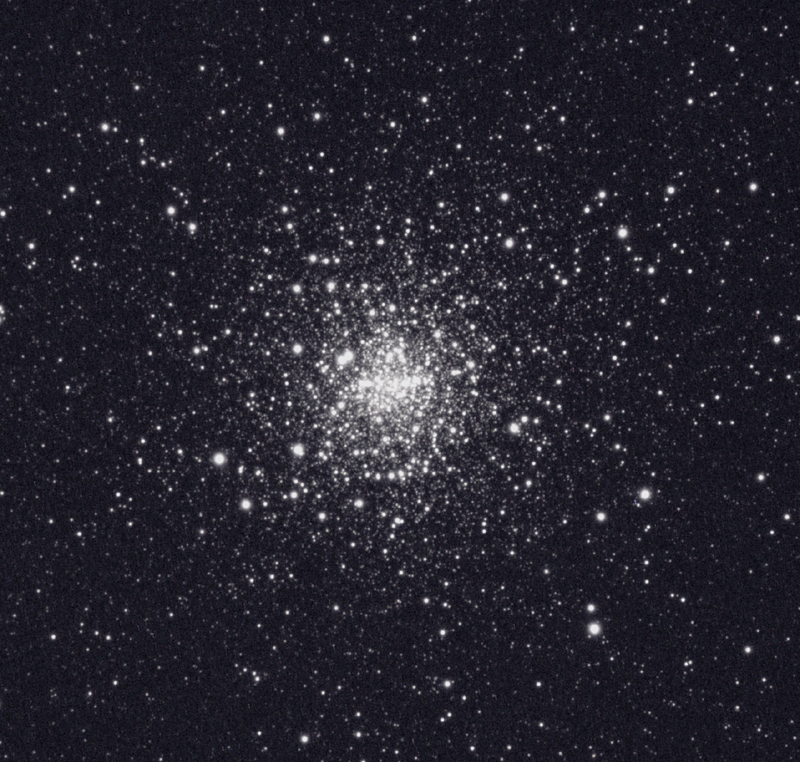
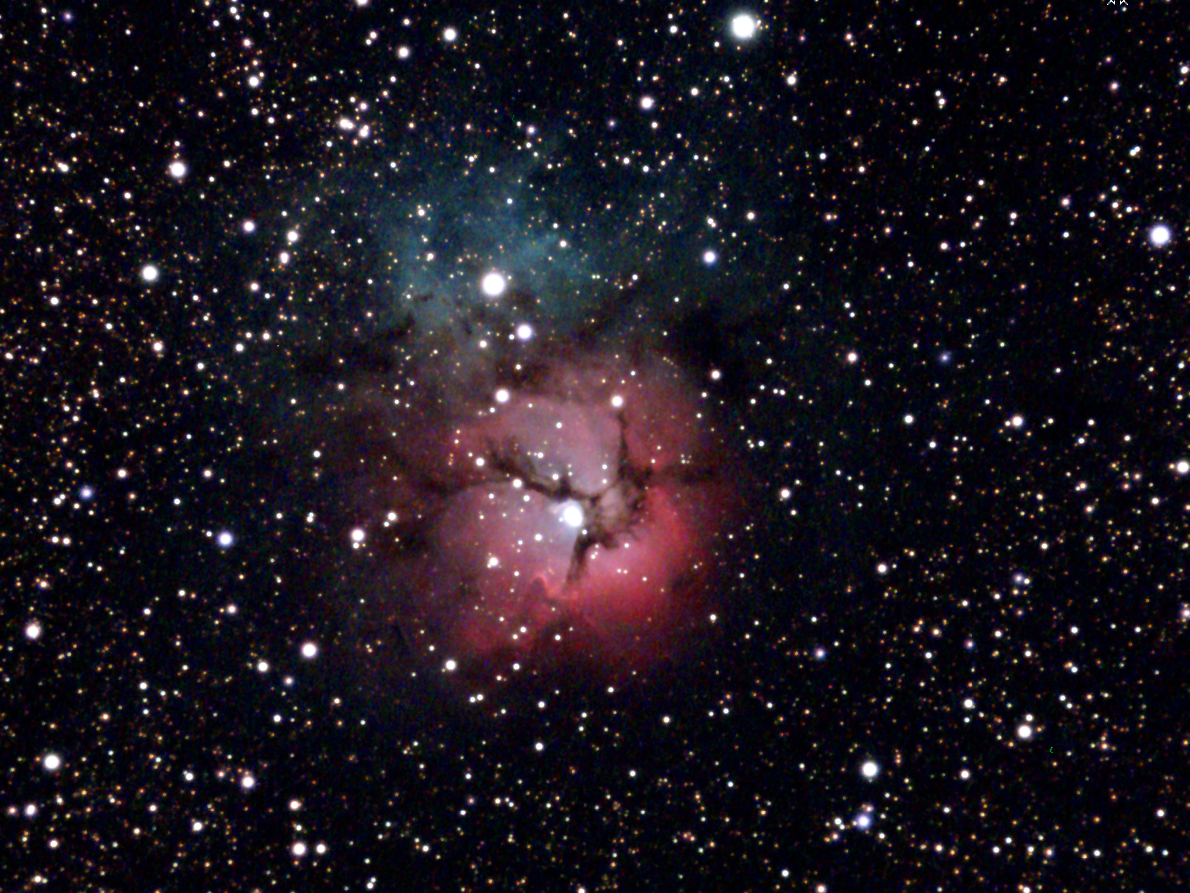
M20 - the Trifid nebula - stack of 5x60s exposures
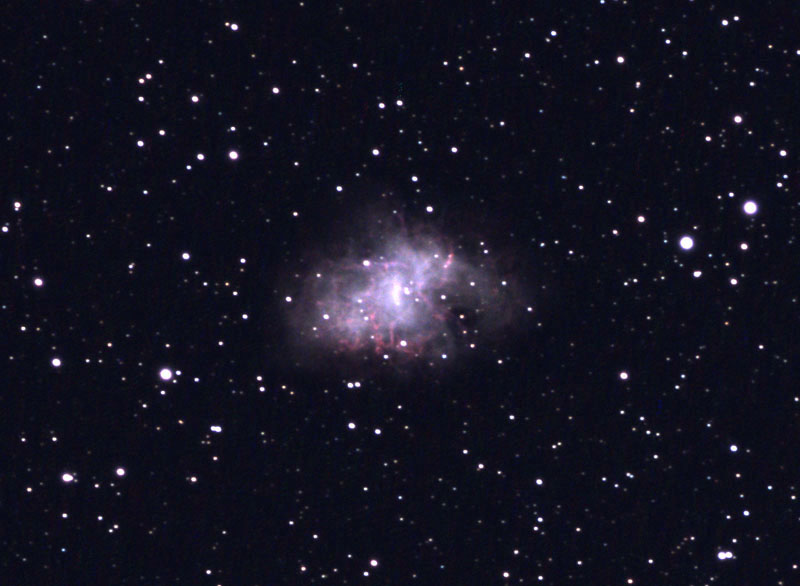
M1 - the Crab Nebula - stack of 7x120s exposures
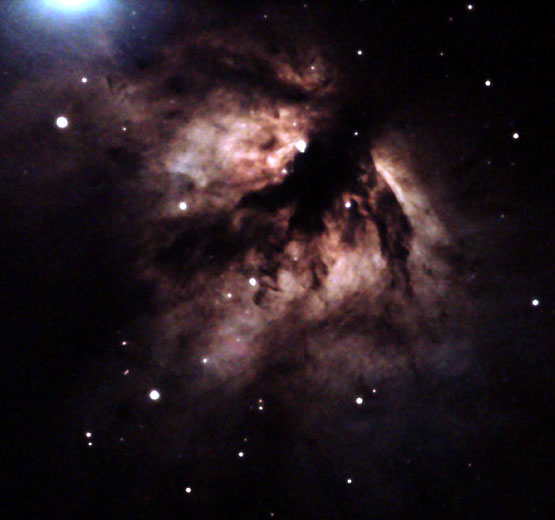
NGC 2024 - the Flame nebula = stack of 4x120s exposures:
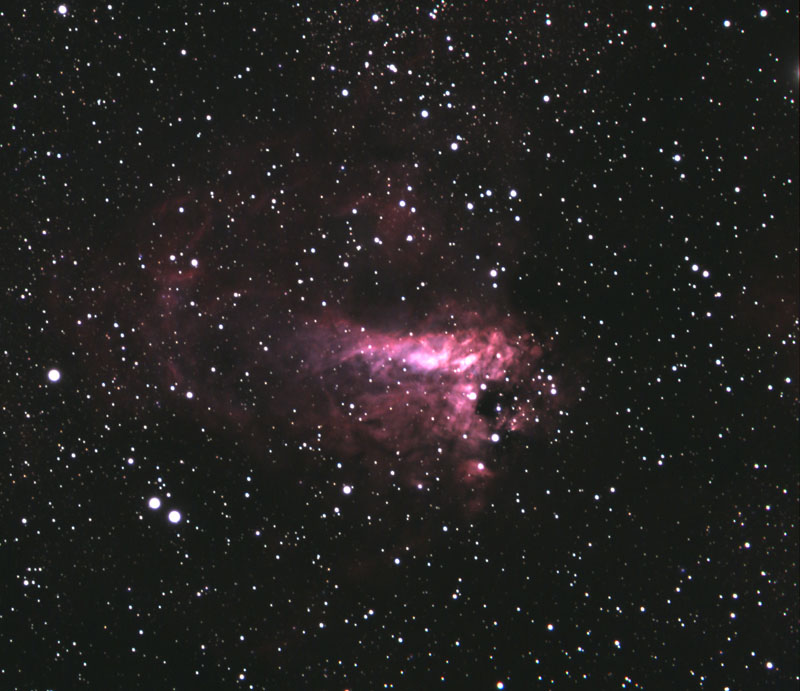
And M17 - the Swan Nebula - a stack of 10x120s exposures
The following photographs were taken with either a 5" TeleVue NP-127 APO, Celestron 9.25" SCT, Celestron 8" SCT, TMB 105/650 APO, or an 80mm WO Super APO on a Vixen Sphinx Mount with a Toucam II webcam or SkyNyx 2.1c Camera. Images were acquired with K3ccdtools and then stacked and processed in Registax. Images were sharpened and tweaked with Adobe Photoshop. All images (c) 2005-2016, C. E. S. Dewar..
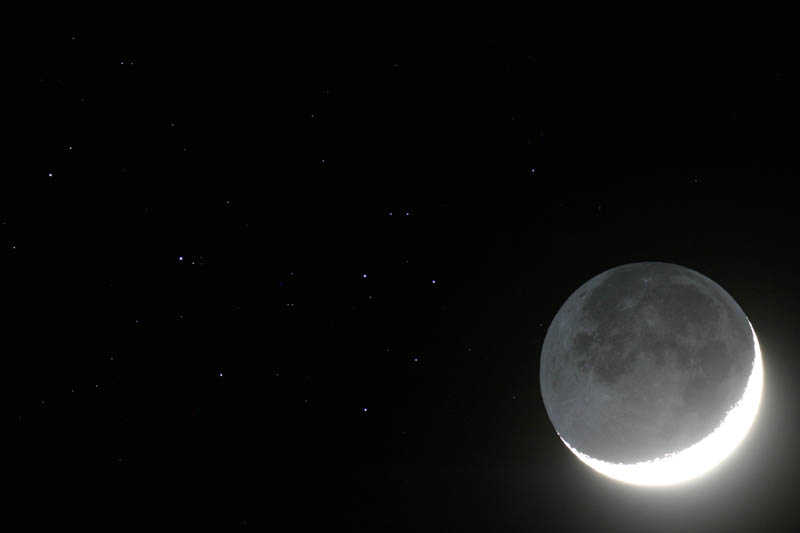 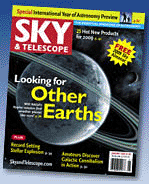
Moon in the Pleiades on 08Apr2008. Canon EOS10D
at ISO100, 4s at F6,
TMB 105/650 at Prime Focus
This image was featured in Sky
& Telescope Magazine's February 2009 issue (page 72).
|
|||
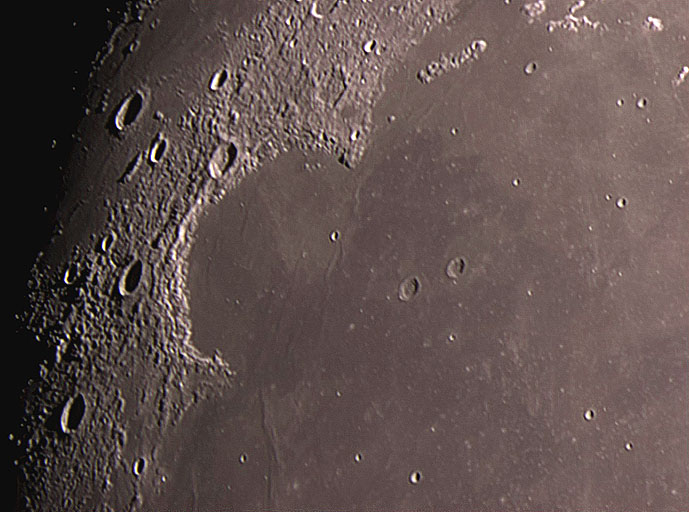 Sinus Iridium - TMB 105/650 at F31 with 5x Powermate, SkyNyx 2.1c Camera. The two craters near center are Helicon (25km) and LeVerrier (20km). Note the subtle striae in the Maria areas. |
|||
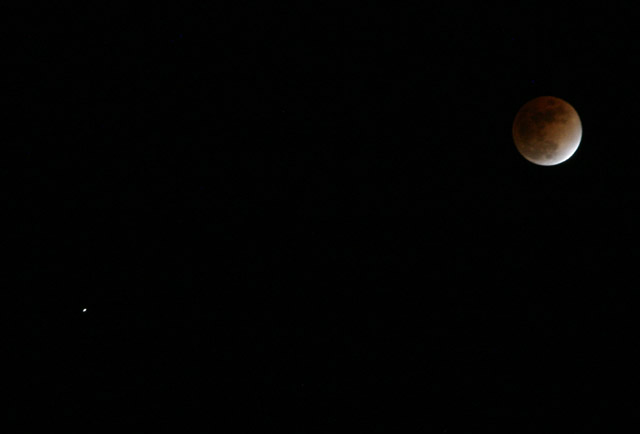
Total Lunar Eclipse on February 20, 2008. Saturn is at lower left. This photograph was taken shortly after the end of totality as it moved out of the umbra. Canon 10-D, Sigma 170-500m Zoom at 500mm. |
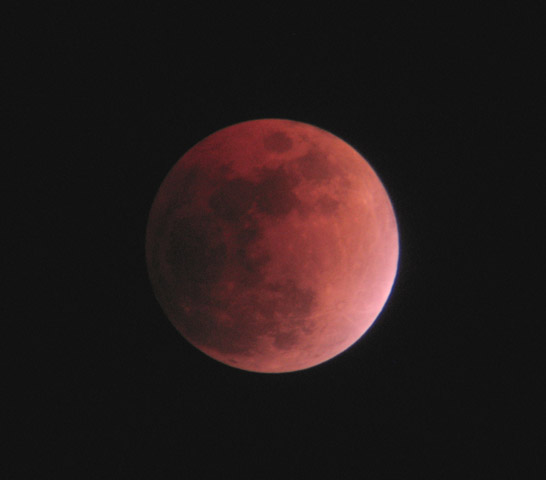
Moon during totality. This was taken with a Canon SD-500
digital camera held up |
||
| Sun | |||
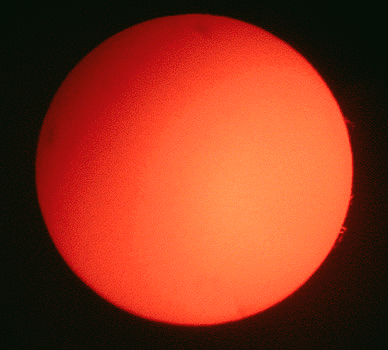
Sun on Jan 27, 2008 - Canon 500 digital camera held up
to the eyepiece |
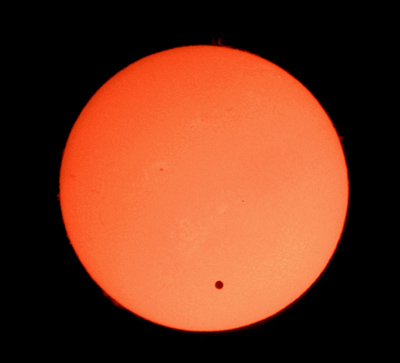
Venus Transit on June 5th 2012. Canon 500 digital camera
held up to the eyepiece |
||
Mercury Transit of May 9, 2016 - Sony RX-100 camera held up to eyepiece of a Coronado H_Alpha Solar Telescope |
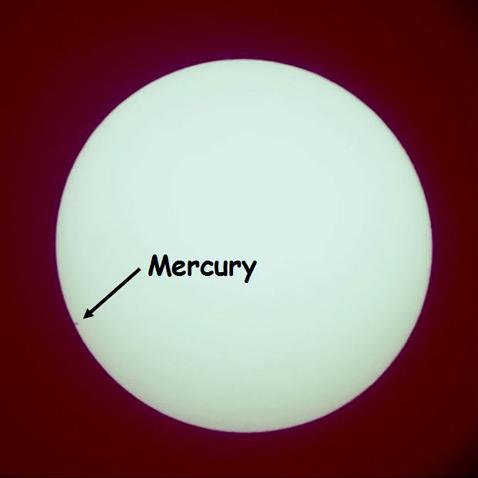 Mercury Transit of May 9, 2016 - Sony RX-100 camera held up to eyepiece of a Coronado H_Alpha Solar Telescope. About 3 minutes before egress. |
||
| Mars | |||
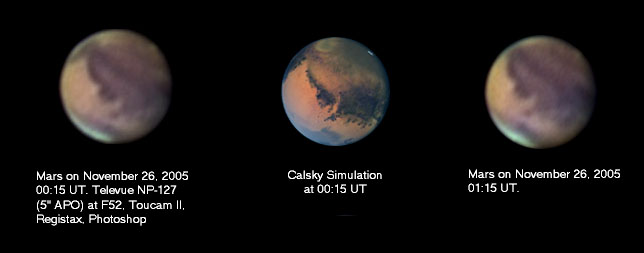
Mars, showing rotation in just one hour.
|
|||
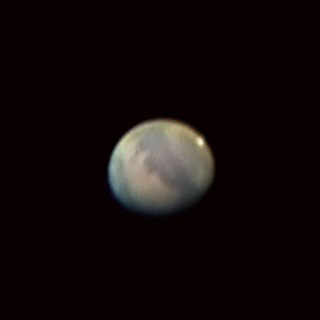 Mars on morning of 19-Sep-2005 (3:30am EST). Image taken with TeleVue NP-127 (5" APO) at f52 (2x/5x TV Barlow/Powermate)
|
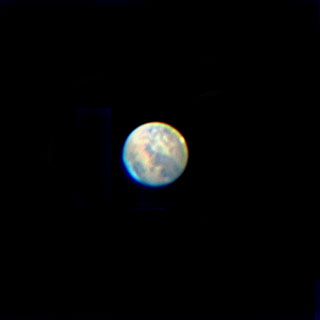
Mars on morning of 21-October-2005 (1:45am EST). Image taken with TeleVue NP-127 (5" APO) at f52 (2x/5x TV Barlow/Powermate). Note the several dust storms at the top - such as the prominent one over Solis Planum.
|
||
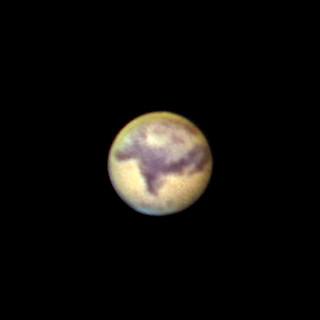
Mars on evening of 29-October-2005 (11:15pm EST). Image taken with TeleVue NP-127 (5" APO) at f52 (2x/5x TV Barlow/Powermate). |
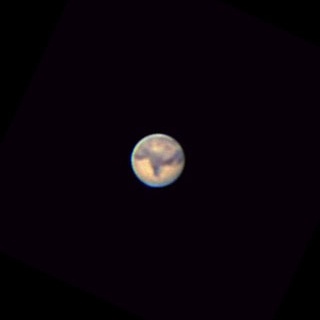
Mars on evening of 28-October-2005 (11:45pm EST). Image taken with a William Optics 80mm Fluorite APO at f60 (2x&5x TV Barlow/Powermates). This is a remarkable image from such a small scope (compare with image on left with the 127mm TeleVue Scope!).
|
||
| Jupiter | |||
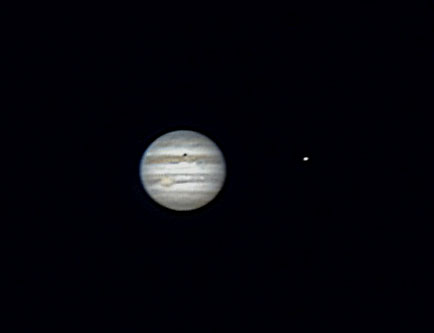
Europa Just about to exit Jupiter (10 0'clock position)
with Io off to the right and a bit more aggressive sharpening to
highlight surface details |
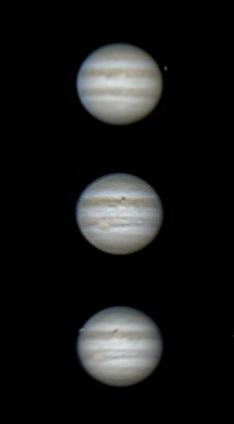
Europa transit across Jupiter on 1-May-2005 (black spot
in second and third images is the shadow of Europa). Third image shows
Europa just exiting (around the 10 o'clock position). Second and third
images also show the Great Red Spot (which is actually a pale orange at
this point) on the left side of the lower equatorial band). |
||
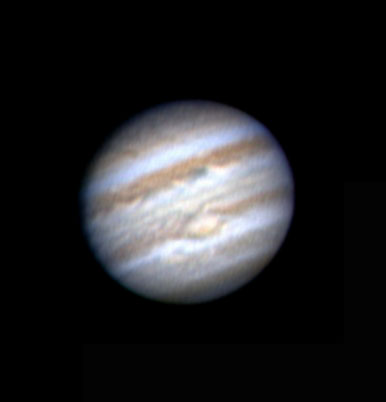
Jupiter on May 17th, 2006 showing GRS and Oval BA (Red
Spot Jr.) just
|
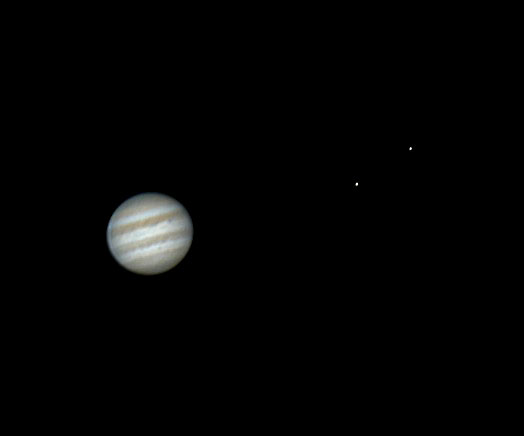
Slightly lower contrast version taken in 2nd week of May, 2005 also with Europa and Io
|
||
|
|
|||
| Saturn | |||
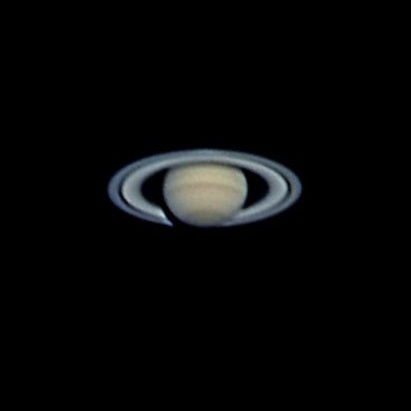 Image of Saturn clearly showing the Cassini division in the rings. The Crepe ring is also visible (esp. right in front of the planet) as is the South South Temperate zone and South equatorial belt, and perhaps a hint of what would be the equatorial band (on the right side). Taken April 22, 2005 |
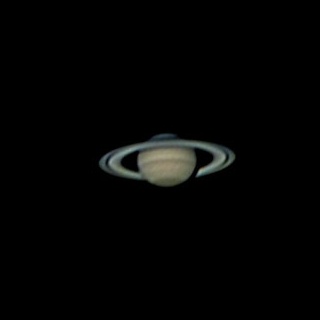
Saturn, November 12, 2005, 3:30am EST, TeleVue NP 127 (5" APO) at f26. Note the prominent storm at the top edge of the South Polar region. |
||
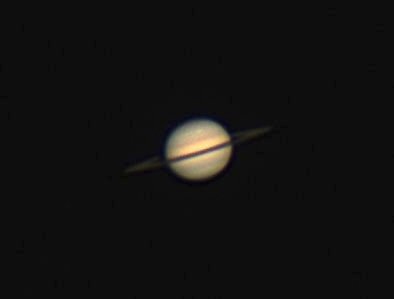 Saturn in June of 2009 as the rings are closing. Televue NP-127 at F26 with SkyNyx 2.1c Camera and Registax. Note the small white spot at top, just right of center - this appears to be the storm which has shown up in several other astrophotographs of Saturn taken at this time. |
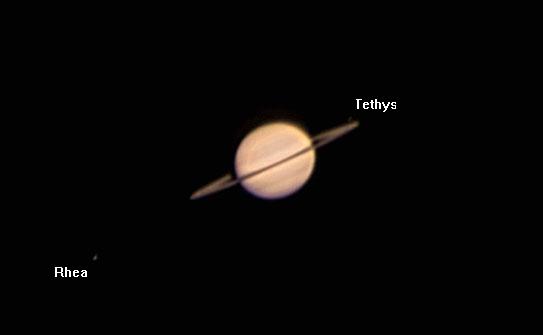
Saturn in June of 2009. Imaged at F16.5 on Rick LaRosa's 28" Webster scope with a SkyNyx 2.1c Camera. Tethys is just barely visible as a small spot above the Cassini Division on the right side. |
||
| The Moon | |||
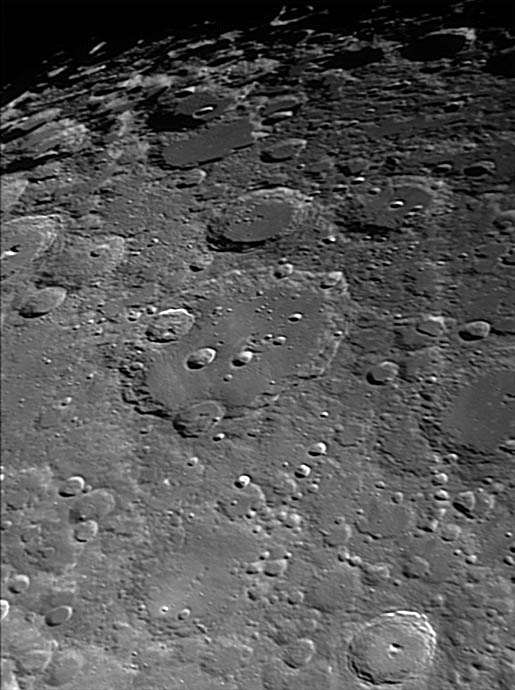
Clavius - taken with a TMB105/650 Refractor at f31 with
a SkyNyx 2.1 Camera |
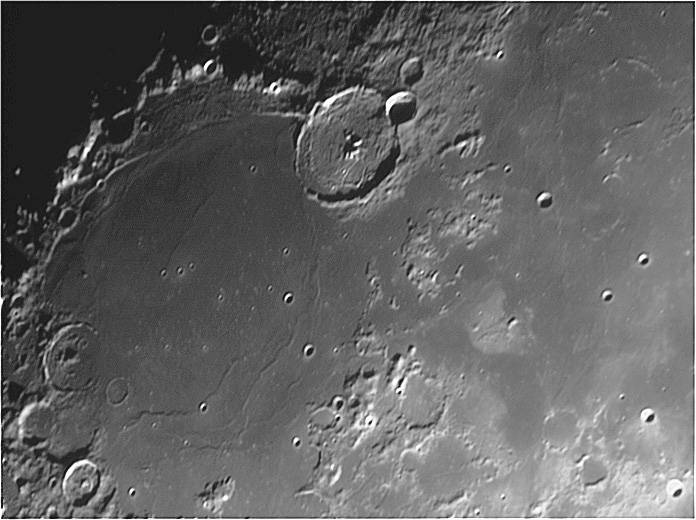
Gassendi and Mare Humorum taken with a TMB105/650
Refractor at f31 with a SkyNyx 2.1 Camera |
||
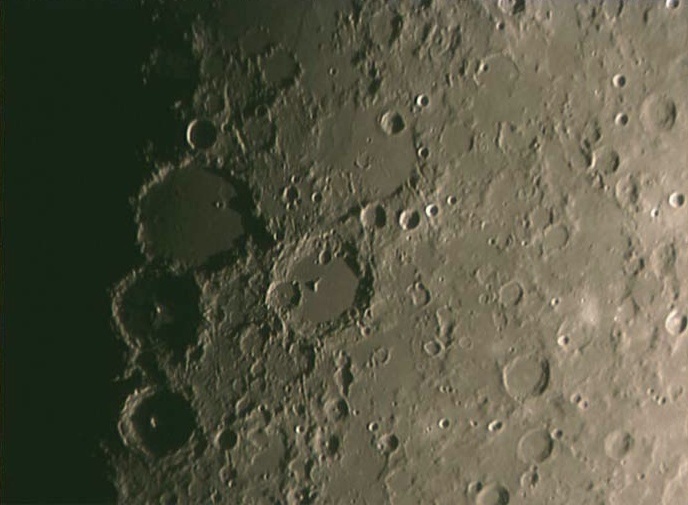
Ptolemaeus, Alphonsus and Arzachel are the three craters
at left on the terminator, with Hipparchus and Albategnius to
|
|||
|
Plato and Vallis Alpes. Taken with a TMB105/650
Refractor at f31 with a SkyNyx 2.1 Camera. Points of interest: |
|||
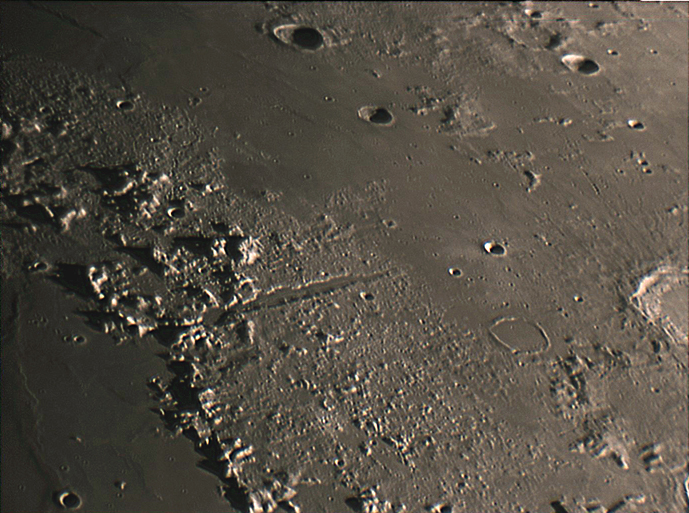
Another photo of Vallis Alpes - this with an 8" SCT
(Celestron C8), SkyNyx 2.1c Camera. Again showing the elusive rille |
|||
|
Rupes Recta (the "Great Wall"). Taken with a Celestron
C8 on a Sphinx Mount at F25 with a SkyNyx 2.1c Camera. |
|||
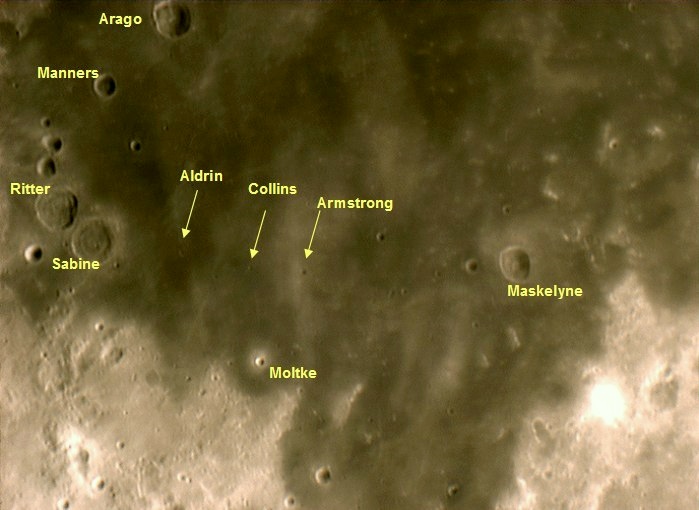
The three craters named after the Apollo 11 astronauts
in the Sea of Tranquility. The smallest crater, Collins, |
|||
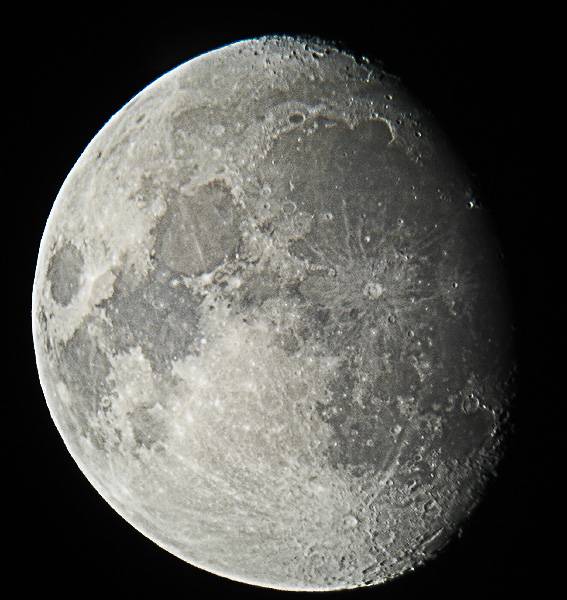 Moon with Saturn III Binoculars - Canon SD-500 digital camera just held up to the eyepiece(!) |
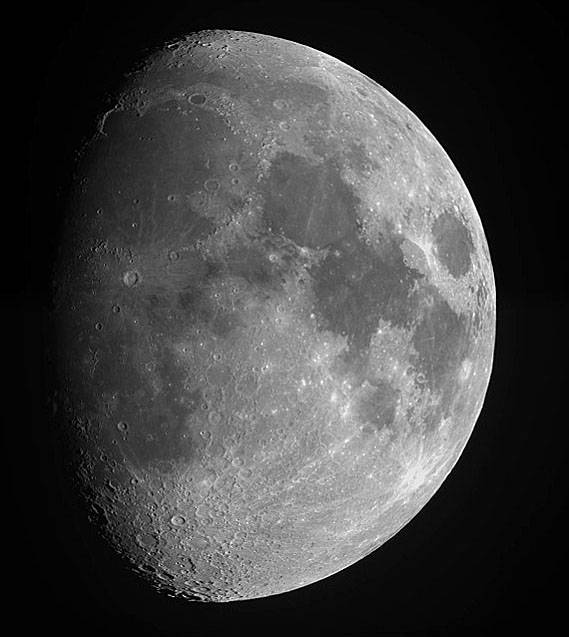
Moon taken with William Optics 80mm SuperAPO at F6 with
SKYnyx Camera - mosaic of two images on an undriven(!) AltAz
mount. |
||
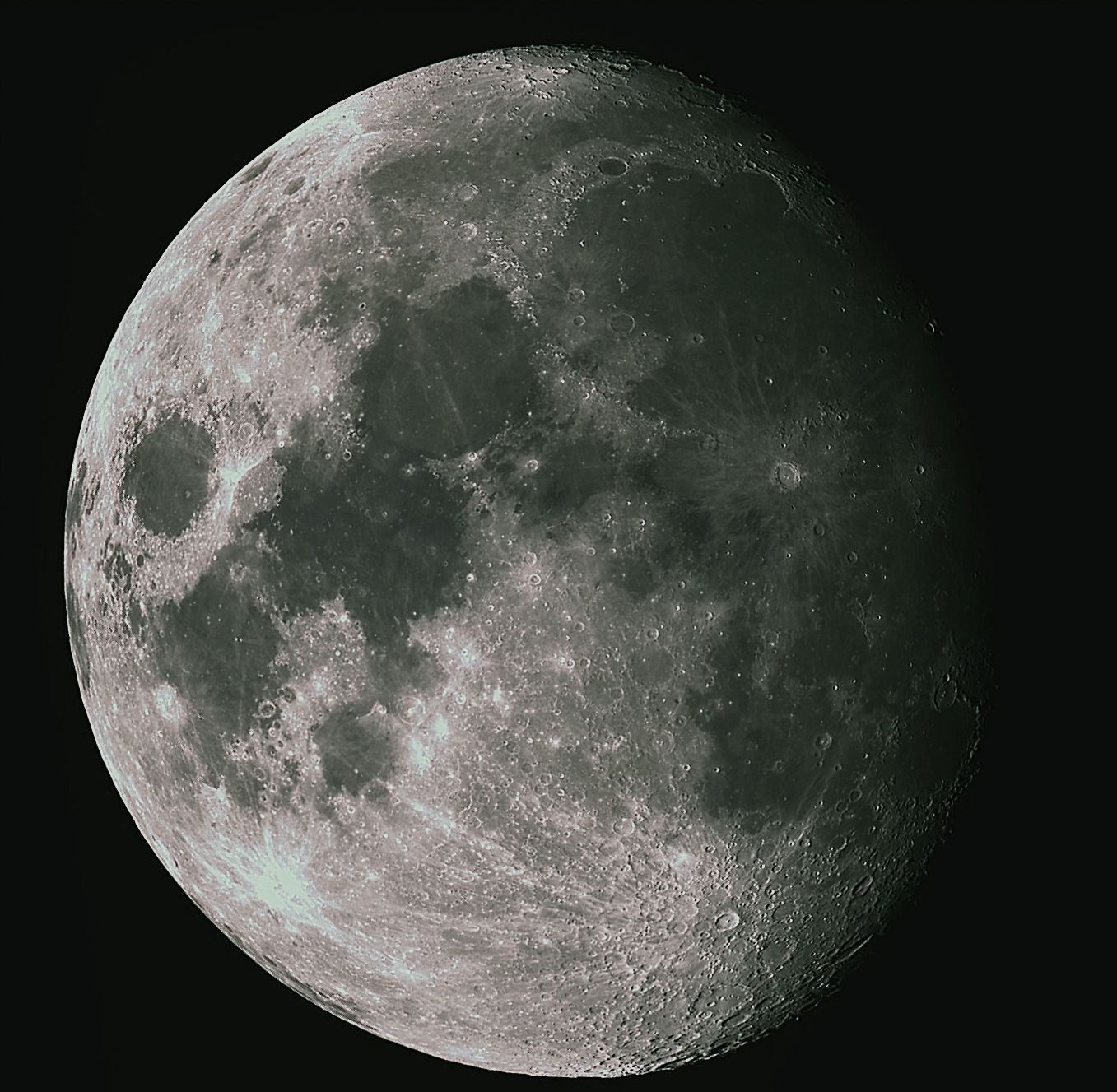
Moon past first quarter. TMB105/650 at F12.4 - mosaic of
two frames from SkyNyx 2.0 camera |
|||
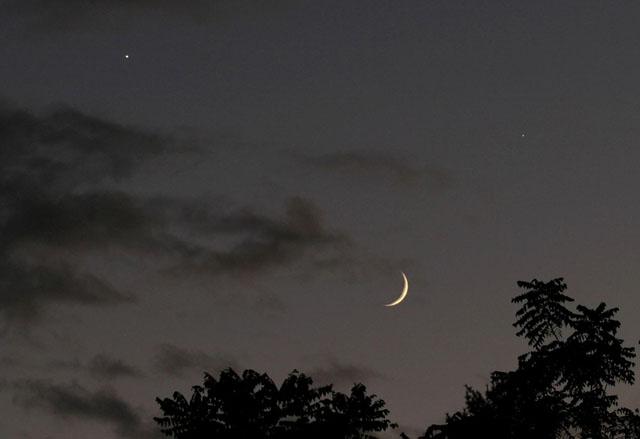
Venus, Moon and Jupiter on evening of September 6th, 2005 |
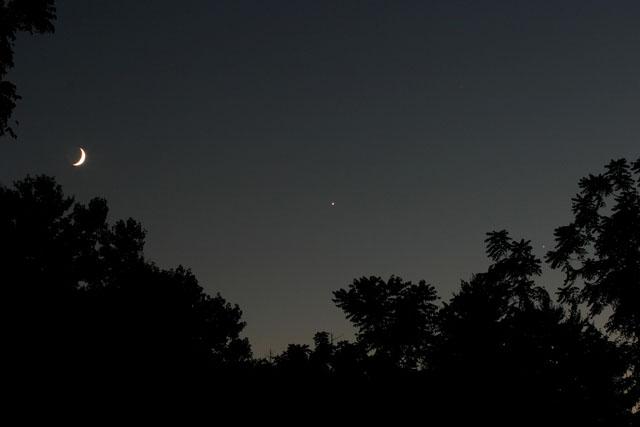
Moon, Venus and Jupiter on evening of September 7th, 2005
|
||
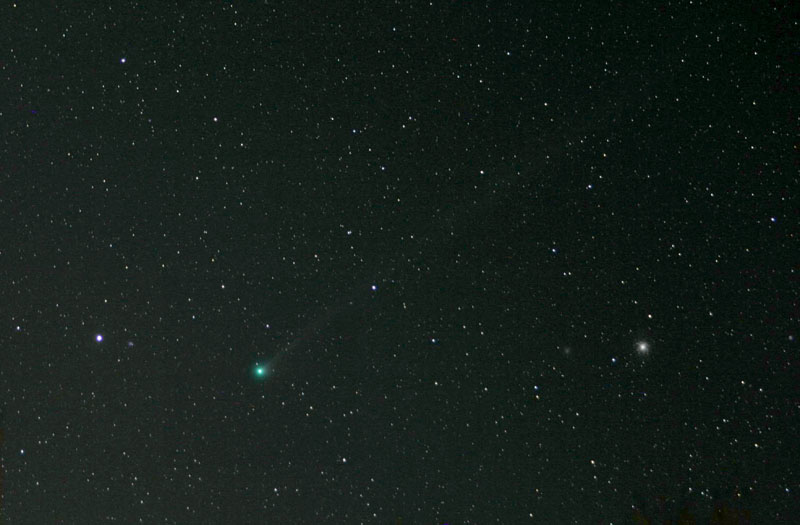 Comet C/2006 M4 (Swan) on night of October 28th, 2006, 2 days after outburst when it suddenly brightened by two full magnitudes. To the right of comet Swan is M13 - the huge globular cluster in Hercules. 8x30s @ F2.8 with 200mm lens on Canon-10D. |
|||
Messier
Marathon 2007 Results: 109 out of 110
And now for something completely
different.... |
|||

|
|||
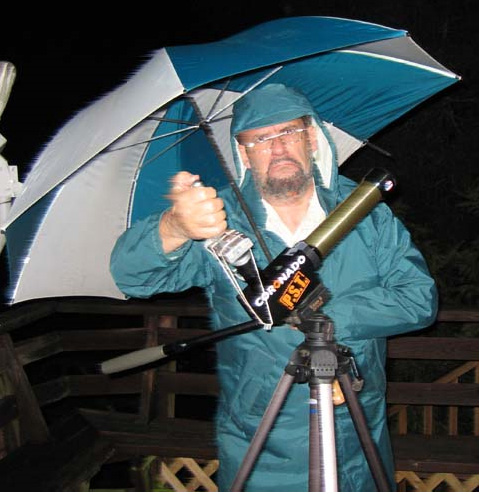
The ever intrepid CESD braving severe thunderstorms on
the night of April 1
|
|||
|
© 2011 Pimlico Software, Inc. All rights reserved |